Abstract
Omission of Ca2+ from the medium of confluent BALB/c3T3 cells for a period of 17 hr causes a large decrease in the number of cells synthesizing DNA. This effect is reversed by raising the Mg2+ concentration of the medium to 20 mM. However, if the [Mg2+] is greater than 20 mM (“ultra-high” Mg2+), there is again a decrease in the number of cells synthesizing DNA. The synthesis of protein has a similar dependence on Mg2+ concentration in Ca2+-deficient medium, but it responds within 45 min of the shift in cation concentrations rather than the 10 hr that is required for the change in DNA synthesis to become apparent. Cells in the ultrahigh Mg2+ concentrations that are at first inhibitory to protein synthesis later return to maximal protein synthesis. This delayed increase in protein synthesis is reflected in a delayed increase in DNA synthesis. Intracellular concentrations of Mg2+ in Ca2+-deficient media increase in proportion to extracellular Mg2+ concentrations. Cells in medium with 30 mM Mg2+ have a high intracellular content of Mg2+ at 3 hr but have decreased their intracellular content by 17 hr, a time at which protein synthesis has been restored to normal. Intracellular Na+ and K+ concentrations also change in Ca2+-deficient medium, but independent variation of these ions shows that protein synthesis is relatively insensitive to their concentration. Intracellular Ca2+ remains fairly constant under all these conditions. The rate of protein synthesis of intact cells changes as a function of intracellular Mg2+ content in a manner very similar to that which has been reported for cell-free systems. We conclude that protein synthesis is very sensitive to small changes in intracellular [Mg2+] within physiological range and that the onset of DNA synthesis is dependent on the rate of protein synthesis. Regulation of the availability of Mg2+ within the cell therefore presents a plausible mechanism for growth control.
Keywords: translational control, sodium, potassium, calcium
Full text
PDF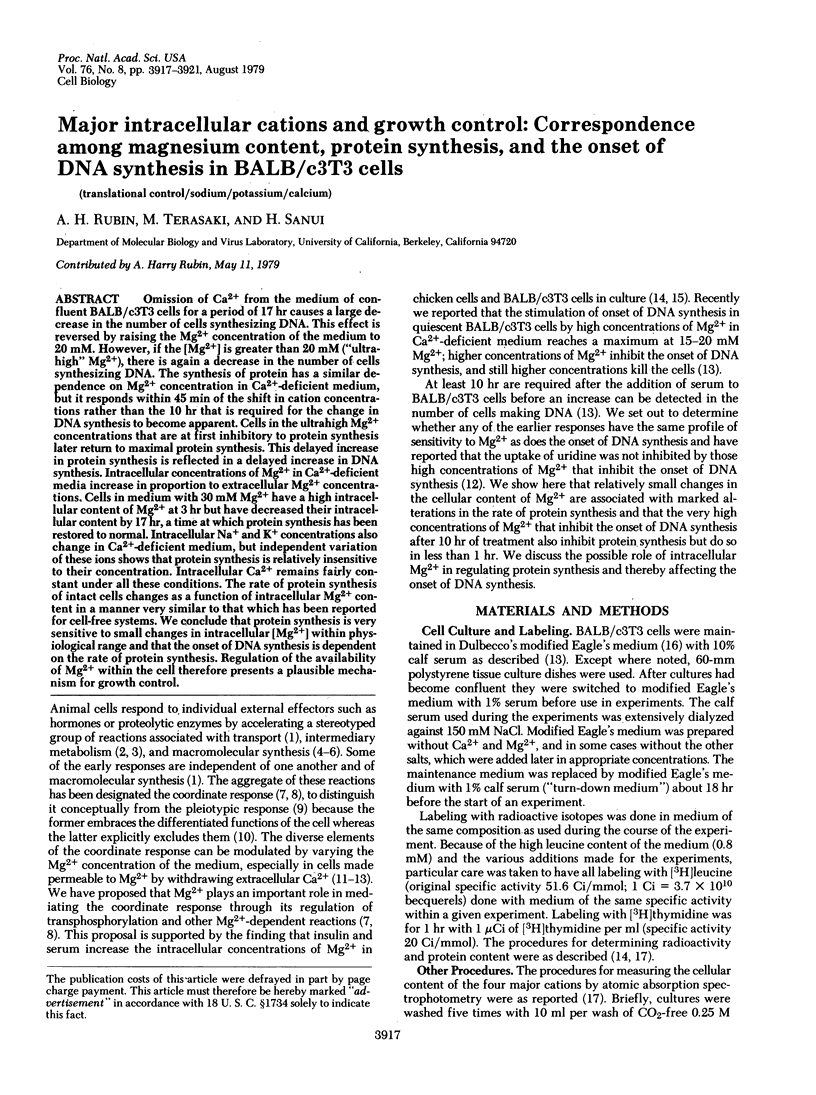
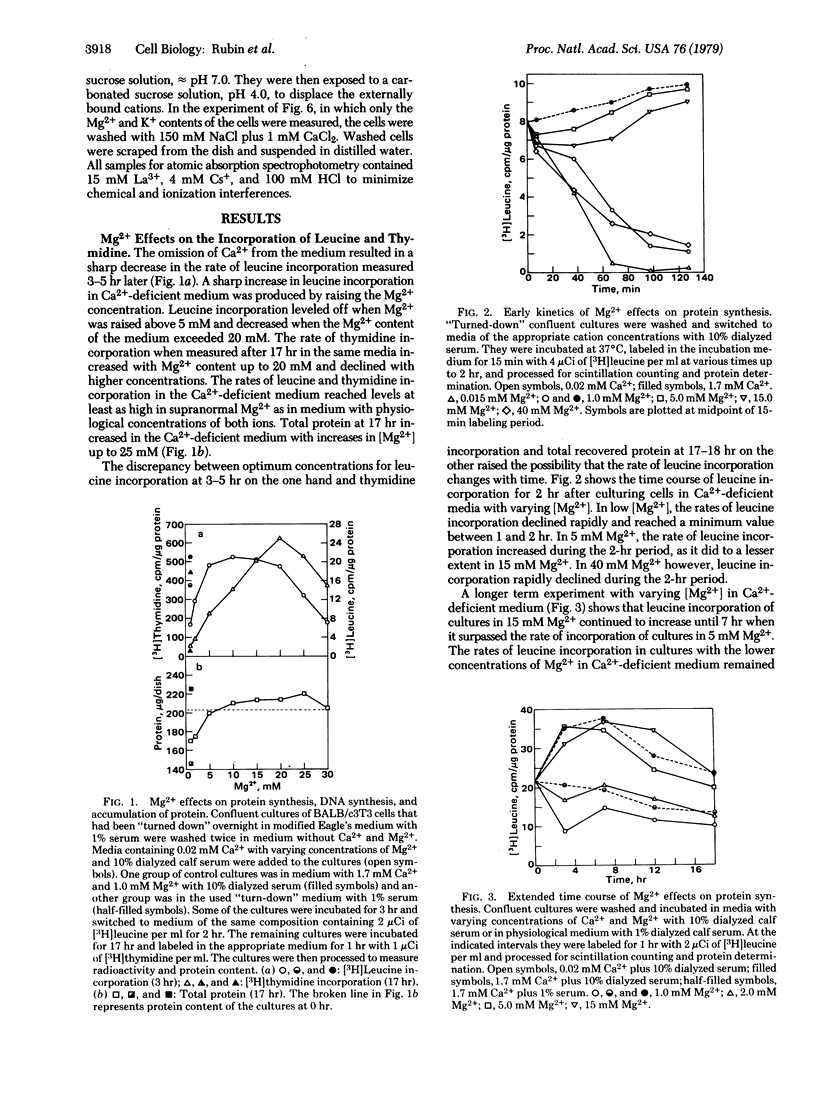
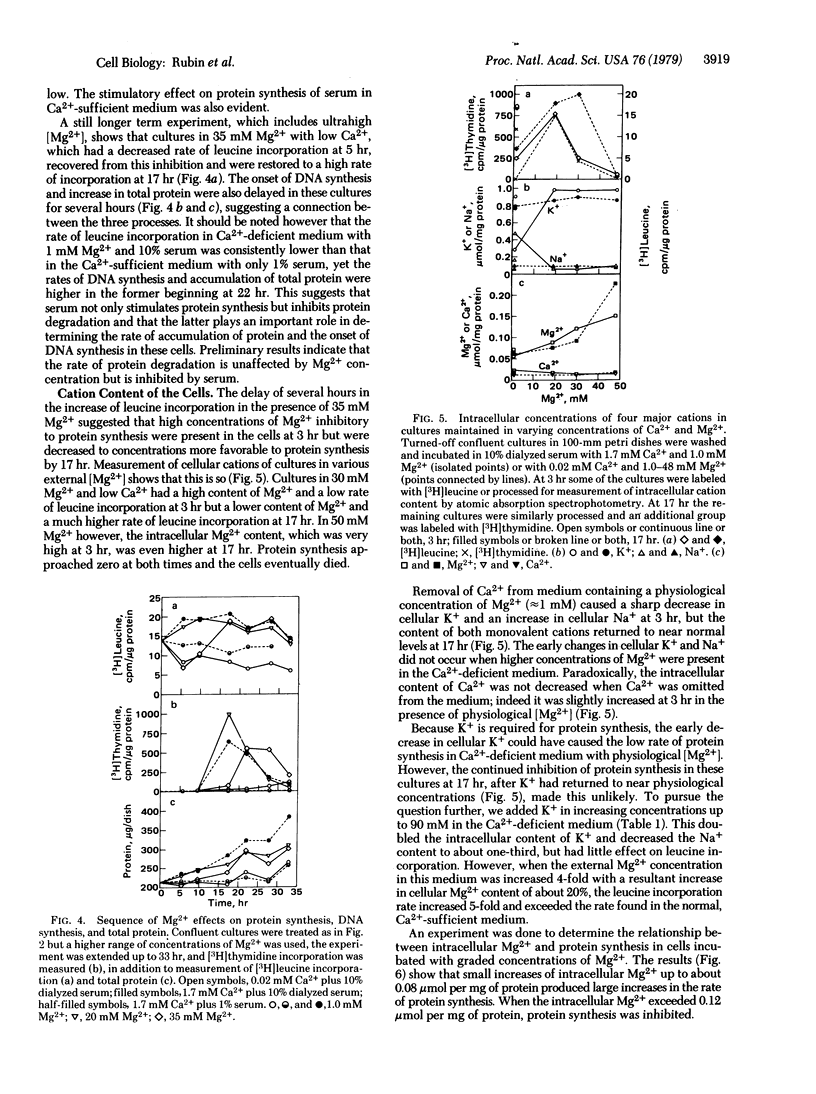
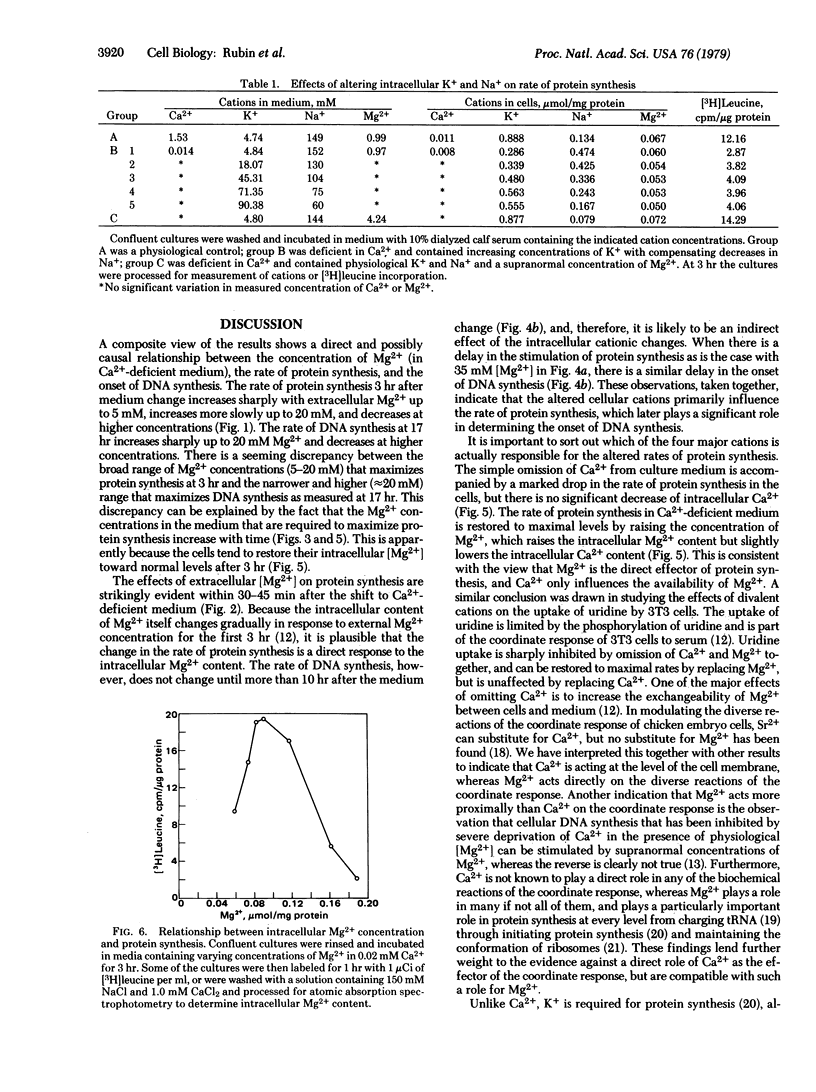
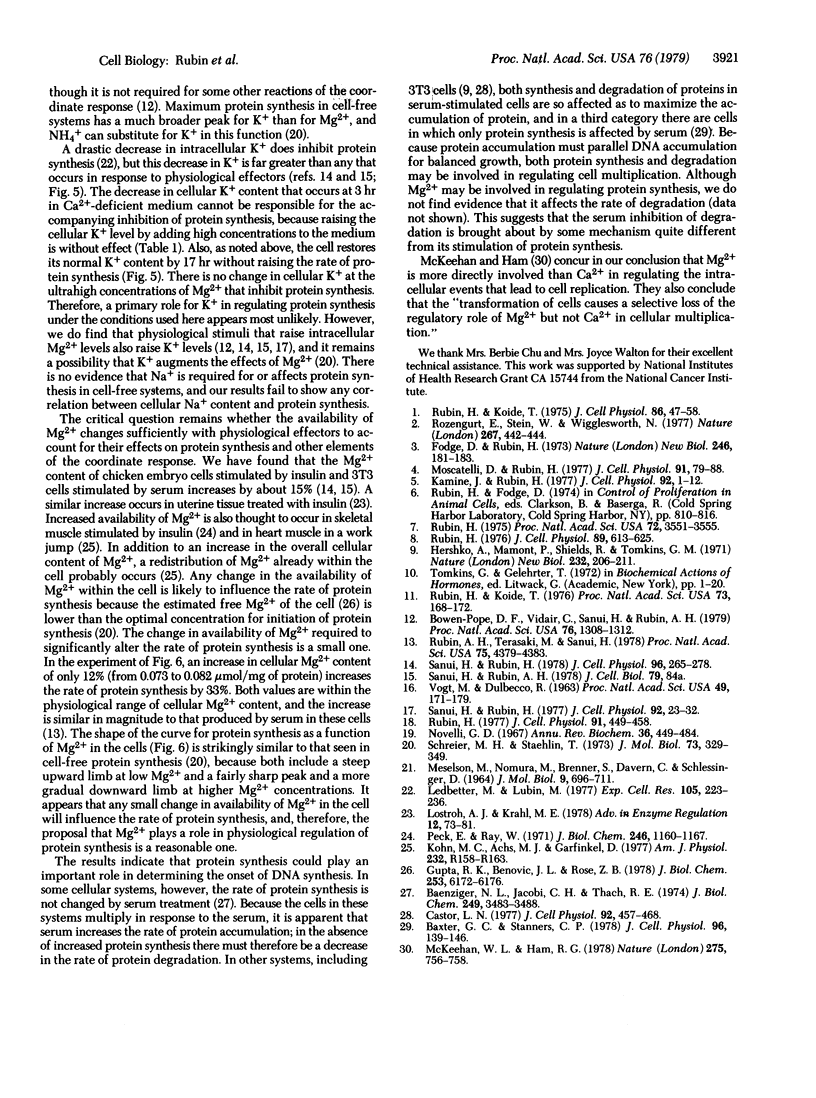
Selected References
These references are in PubMed. This may not be the complete list of references from this article.
- Baenziger N. L., Jacobi C. H., Thach R. E. Regulation of protein synthesis during density-dependent growth inhibition of BHK21-13 cells. J Biol Chem. 1974 Jun 10;249(11):3483–3488. [PubMed] [Google Scholar]
- Baxter G. C., Stanners C. P. The effect of protein degradation on cellular growth characteristics. J Cell Physiol. 1978 Aug;96(2):139–145. doi: 10.1002/jcp.1040960202. [DOI] [PubMed] [Google Scholar]
- Bowen-Pope D. F., Vidair C., Sanui H., Rubin A. H. Separate roles for calcium and magnesium in their synergistic effect on uridine uptake by cultured cells: significance for growth control. Proc Natl Acad Sci U S A. 1979 Mar;76(3):1308–1312. doi: 10.1073/pnas.76.3.1308. [DOI] [PMC free article] [PubMed] [Google Scholar]
- Castor L. N. Responses of protein synthesis and degradation in growth control of WI-38 cells. J Cell Physiol. 1977 Sep;92(3):457–467. doi: 10.1002/jcp.1040920313. [DOI] [PubMed] [Google Scholar]
- Fodge D. W., Rubin H. Activation of phosphofructokinase by stimulants of cell multiplication. Nat New Biol. 1973 Dec 12;246(154):181–183. doi: 10.1038/newbio246181a0. [DOI] [PubMed] [Google Scholar]
- Gupta R. K., Benovic J. L., Rose Z. B. The determination of the free magnesium level in the human red blood cell by 31P NMR. J Biol Chem. 1978 Sep 10;253(17):6172–6176. [PubMed] [Google Scholar]
- Hershko A., Mamont P., Shields R., Tomkins G. M. "Pleiotypic response". Nat New Biol. 1971 Aug;232(33):206–211. [PubMed] [Google Scholar]
- Kamine J., Rubin H. Coordinate control of collagen synthesis and cell growth in chick embryo fibroblasts and the effect of viral transformation on collagen synthesis. J Cell Physiol. 1977 Jul;92(1):1–11. doi: 10.1002/jcp.1040920102. [DOI] [PubMed] [Google Scholar]
- Kohn M. C., Achs M. J., Garfinkel D. Distribution of adenine nucleotides in the perfused rat heart. Am J Physiol. 1977 May;232(5):R158–R163. doi: 10.1152/ajpregu.1977.232.5.R158. [DOI] [PubMed] [Google Scholar]
- Ledbetter M. L., Lubin M. Control of protein synthesis in human fibroblasts by intracellular potassium. Exp Cell Res. 1977 Mar 15;105(2):223–236. doi: 10.1016/0014-4827(77)90120-3. [DOI] [PubMed] [Google Scholar]
- Lostroh A. J., Krahl M. E. Magnesium, a second messenger for insulin: ion translocation coupled to transport activity. Adv Enzyme Regul. 1974;12:73–81. doi: 10.1016/0065-2571(74)90007-7. [DOI] [PubMed] [Google Scholar]
- MESELSON M., NOMURA M., BRENNER S., DAVERN C., SCHLESSINGER D. CONSERVATION OF RIBOSOMES DURING BACTERIAL GROWTH. J Mol Biol. 1964 Sep;9:696–711. doi: 10.1016/s0022-2836(64)80176-5. [DOI] [PubMed] [Google Scholar]
- McKeehan W. L., Ham R. G. Calcium and magnesium ions and the regulation of multiplication in normal and transformed cells. Nature. 1978 Oct 26;275(5682):756–758. doi: 10.1038/275756a0. [DOI] [PubMed] [Google Scholar]
- Moscatelli D., Rubin H. Hormonal control of hyaluronic acid production in fibroblasts and its relation to nucleic acid and protein synthesis. J Cell Physiol. 1977 Apr;91(1):79–88. doi: 10.1002/jcp.1040910109. [DOI] [PubMed] [Google Scholar]
- Peck E. J., Jr, Ray W. J., Jr Metal complexes of phosphoglucomutase in vivo. Alterations induced by insulin. J Biol Chem. 1971 Feb 25;246(4):1160–1167. [PubMed] [Google Scholar]
- Rozengurt E., Stein W. D., Wigglesworth N. M. Uptake of nucleosides in density-inhibited cultures of 3T3 cells. Nature. 1977 Jun 2;267(5610):442–444. doi: 10.1038/267442a0. [DOI] [PubMed] [Google Scholar]
- Rubin A. H., Terasaki M., Sanui H. Magnesium reverses inhibitory effects of calcium deprivation on coordinate response of 3T3 cells to serum. Proc Natl Acad Sci U S A. 1978 Sep;75(9):4379–4383. doi: 10.1073/pnas.75.9.4379. [DOI] [PMC free article] [PubMed] [Google Scholar]
- Rubin H. Central role for magnesium in coordinate control of metabolism and growth in animal cells. Proc Natl Acad Sci U S A. 1975 Sep;72(9):3551–3555. doi: 10.1073/pnas.72.9.3551. [DOI] [PMC free article] [PubMed] [Google Scholar]
- Rubin H., Koide T. Early cellular responses to diverse growth stimuli independent of protein and RNA synthesis. J Cell Physiol. 1975 Aug;86(1):47–58. doi: 10.1002/jcp.1040860107. [DOI] [PubMed] [Google Scholar]
- Rubin H., Koide T. Mutual potentiation by magnesium and calcium of growth in animal cells. Proc Natl Acad Sci U S A. 1976 Jan;73(1):168–172. doi: 10.1073/pnas.73.1.168. [DOI] [PMC free article] [PubMed] [Google Scholar]
- Rubin H. Magnesium deprivation reproduces the coordinate effects of serum removal or cortisol addition on transport and metabolism in chick embryo fibroblasts. J Cell Physiol. 1976 Dec;89(4):613–625. doi: 10.1002/jcp.1040890418. [DOI] [PubMed] [Google Scholar]
- Rubin H. Specificity of the requirements for magnesium and calcium in the growth and metabolism of chick embryo fibroblasts. J Cell Physiol. 1977 Jun;91(3):449–458. doi: 10.1002/jcp.1040910315. [DOI] [PubMed] [Google Scholar]
- Sanui H., Rubin A. H. Membrane bound and cellular cationic changes associated with insulin stimulation of cultured cells. J Cell Physiol. 1978 Sep;96(3):265–278. doi: 10.1002/jcp.1040960302. [DOI] [PubMed] [Google Scholar]
- Sanui H., Rubin H. Correlated effects of external magnesium on cation content and DNA synthesis in culture chicken embryo fibroblasts. J Cell Physiol. 1977 Jul;92(1):23–31. doi: 10.1002/jcp.1040920104. [DOI] [PubMed] [Google Scholar]
- Schreier M. H., Staehelin T. Initiation of mammalian protein synthesis: the importance of ribosome and initiation factor quality for the efficiency of in vitro systems. J Mol Biol. 1973 Feb 19;73(3):329–349. doi: 10.1016/0022-2836(73)90346-x. [DOI] [PubMed] [Google Scholar]
- VOGT M., DULBECCO R. Steps in the neoplastic transformation of hamster embryo cells by polyoma virus. Proc Natl Acad Sci U S A. 1963 Feb 15;49:171–179. doi: 10.1073/pnas.49.2.171. [DOI] [PMC free article] [PubMed] [Google Scholar]


